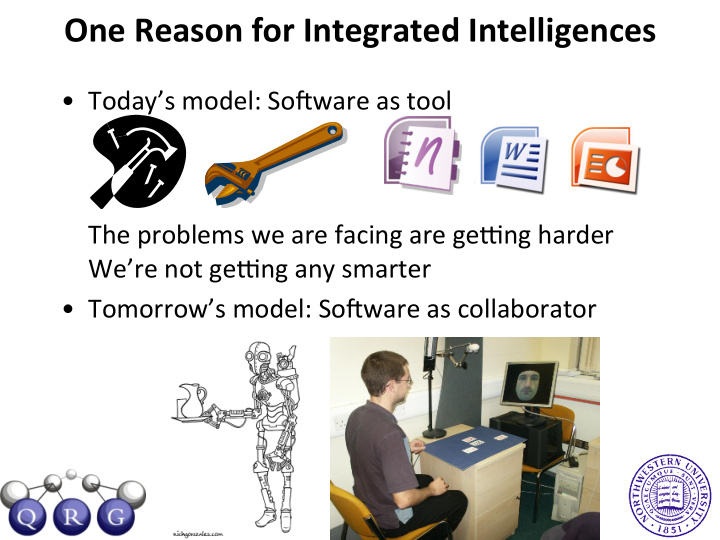



One Reason for Integrated Intelligences • Today’s model: So/ware as tool The problems we are facing are ge;ng harder We’re not ge;ng any smarter • Tomorrow’s model: So/ware as collaborator
Another Reason: Understanding how Minds Work Unified Theories of Cogni7on (Newell, 1990)
Today ’ s AI systems can be fast and effec@ve But they are carefully designed for narrow niches, maintained by highly trained personnel What if AI systems were as robust, trainable, and taskable as dogs?
Summaries of One-pagers • Organisms – Delibera@ve autonomy (Aha) – Data efficient learning (Chai) – Self-awareness (de Kleer) – Forms of intergra@on (Fischer, Laird, Rosenbloom) – Interac@ve task learning (Chai, Laird) • Knowledge – Commonsense (Chai,de Kleer, Muller) – Causality (Chai, de Kleer, Hunter) – Metaknowledge (de Kleer, Leake) – About people (Chai, Oh, Wilson)
More summaries • Communica@on – Seman@c percep@on (aha) – Grounding language (Chai, Oh) – Mul@modal interac@on (Chai, Coman, Oh, Wilson, Woolf) • Use Scenarios – Life partners, DevOps (Aha) – Customer Service (Coman, Muller) – Design (de Kleer) – Assistants for comp. Sustainability (Fischer) – Eldercare (Oh, Wilson) – Mentor for everyone (Woolf)
Arcs of Progress • Stretch goals to excite the imagina@on • End state: 2040 • Iden@fy milestones along the way • Analysis of capabili@es
2050 Goal • AI tutors, coaches, partners, and mentors that support people who want to learn any area of science, at any level, any @me • One of the proposed tests in a suite to replace the Turing Test (AAAI 2015) – Daun@ng challenge – Clear benefits to society – Science Learning & Teaching Working Group: Ken Forbus, Peter Clark, Chen Liang, Nina N., Chris@an Lebiere, Gabor Melli, Jim Spohrer, Melanie Swan
There are Never Enough People to Help with Educa7on • Not enough teachers • Not enough tutors • Not enough teammates • Not available when you need them – Finishing homework at 3am the night before it is due • Not for as long as you need them • Don’t know you like friends and family do – Shared experiences as a source of examples
Vision: AI Assistants for Learning Science Now: CogSketch, Companions, PSLC, Cyc, IBM’s Watson, Seman@c Web, new sensors… Provide individual technologies and ini@al architectures Mul7modal Science Learners : AIs that can learn science from people via reading, dialogue, sketching, and vision. Barriers: Learning at scale, interac@vely, at human-like rates. Fluent communica@on. Mul7modal Science Tutors : AIs that can help people learn science. 2050: AI tutors, coaches, & mentors that support people who want to learn any area of science, at any level, any @me.
Dimension: Knowledge & Reasoning • Depth of exper@se • Breadth of coverage • Current state – 8 th grade science tests, > 700 teams using sta@s@cal NLP and deep learning, 60% = best score – 4 th grade science tests, AI2’s Aristo, sta@s@cal NLP + some reasoning, 70% – Mul@ple choice, no diagrams
Dimension: Learning • How easily can systems be instructed? – Human students don’t need millions of examples to learn algebra (or anything else) • Learning by reading – Vary by grade levels – Mul@modal: Diagrams are essen@al • Interac@ve knowledge capture – Already can provide educa@onal value, if students can learn by teaching AIs
Dimension: Communica7ons • Teaching, mentoring, coaching… • Mul@ple modali@es – Language, sketching, gesture • Ability to learn rapidly from students – True Socra@c dialogs – So/ware needs to keep up with culturally relevant examples • Build up rela@onships over weeks, months, years
Personal Assistant Arc Personalized integrated learning assistants for Siri, Cortana, Alex Planning for complex tasks (“smart control” of (constrained) Early ITS, 2040 specific apps real-world partial-order 2011, 2014 applications Usable levels of planning 1990s speech/NLP, 1970s Eliza Furby, AIBO Discourse integrated planning chatbot interactive pets modeling & decision making 1965 1998-1999 1986 2030 1965 1970 1980 1990 2000 2010 2020 2030 2040
What might you worry about?
Recommend
More recommend